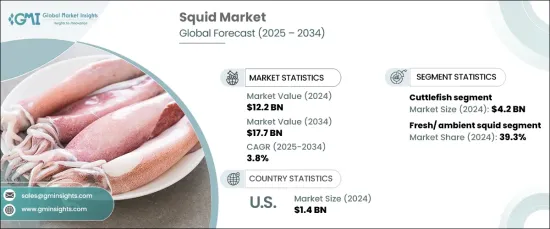
세계의 오징어 시장은 2024년에는 122억 달러로 평가되었으며, 2025년부터 2034년까지 CAGR 3.8%로 안정적인 성장을 할 것으로 예측됩니다.
이국적인 해산물에 대한 소비자의 식욕이 계속 증가함에 따라 오징어는 전 세계 많은 요리에서 인기 있는 별미로 자리 잡았습니다. 독특한 풍미와 다용도로 잘 알려진 오징어는 통오징어부터 말린 오징어 스낵, 오징어 링, 오징어 스테이크와 같은 인기 가공품에 이르기까지 다양한 형태로 선보입니다. 새로운 요리 경험에 대한 소비자의 관심이 높아지면서 프리미엄 해산물에 대한 수요가 급증함에 따라 오징어 시장이 더욱 확대되고 있습니다.

오징어 시장은 포장, 유통 및 물류의 발전으로 신선하고 가공된 오징어가 그 어느 때보다 효과적으로 국제 시장에 도달할 수 있게 된 덕분에 눈에 띄는 성장을 보였습니다. 고단백, 저지방 등 해산물의 건강 효능에 대한 소비자 인식이 높아진 것도 수요 급증에 기여했습니다. 또한 오징어는 많은 고급 레스토랑과 지중해식, 일식 및 기타 아시아 요리에서 중요한 역할을 하며 글로벌 식품 업계에서 입지를 강화하고 있습니다. 그러나 오징어 산업은 공급망과 가용성에 영향을 미치는 남획과 기후 변화로 인한 위협 등 심각한 장애물에 직면해 있습니다. 이러한 도전에 대응하여 지속 가능한 양식 노력과 수산 규제는 장기적으로 오징어 공급을 확보할 수 있는 솔루션을 제공하여 시장을 안정화시키는 데 도움을 주고 있습니다.
| 시장 범위 | |
|---|---|
| 시작 연도 | 2024년 |
| 예측 연도 | 2025-2034년 |
| 시작 금액 | 122억 달러 |
| 예측 금액 | 177억 달러 |
| CAGR | 3.8% |
오징어 제품은 어종별로 분류되며, 일본산 날오징어, 갑오징어, 아르헨티나산 숏핀 오징어, 유럽산 오징어가 주요 경쟁자입니다. 갑오징어 부문은 2024년 42억 달러의 수익을 창출하며 시장을 주도할 것으로 예상됩니다. 부드러운 식감과 풍부한 풍미로 유명한 갑오징어는 폭넓은 소비자층을 확보하고 있어 계속해서 우위를 점하고 있습니다. 유럽 오징어 또한 다용도성과 요리적 가치 덕분에 특히 유럽 가정과 레스토랑에서 시장에서 두드러진 역할을 하고 있습니다.
시장은 제품 형태에 따라 더 세분화되며 신선 오징어, 냉장 오징어, 냉동 오징어가 주요 카테고리입니다. 신선 및 냉장 오징어는 2024년 전체 시장 점유율의 39.3%를 차지하며 가장 빠르게 성장하는 부문입니다. 최소한의 가공을 거친 고품질 해산물에 대한 수요가 증가함에 따라 신선 오징어는 프리미엄 요식업소에서 특히 인기가 높습니다. 특히 오징어가 필수 식재료인 지중해식, 일식, 기타 아시아 요리에서 인기가 높습니다.
미국 시장에서 오징어는 건강한 단백질 대체 식품으로 해산물을 선호하는 소비자의 증가에 힘입어 2024년 14억 달러의 가치를 지닌 식품으로 평가되었습니다. 오징어를 활용한 지중해 및 아시아 요리의 인기도 이러한 성장에 기여했습니다. 미국 해안선을 따라 지속 가능한 어업 관행과 콜드체인 물류의 개선으로 신선 오징어와 냉동 오징어를 안정적으로 공급하여 증가하는 수요를 충족할 수 있게 되었습니다.
The Global Squid Market was valued at USD 12.2 billion in 2024 and is set to grow at a steady CAGR of 3.8% from 2025 to 2034. As consumer appetite for exotic seafood continues to rise, squid has earned its place as a highly sought-after delicacy in many cuisines around the world. Known for its unique flavor profile and versatility, squid is featured in a variety of forms, from whole fresh squid to popular processed items like dried squid snacks, calamari rings, and squid steaks. The surge in demand for premium seafood options, driven by growing consumer interest in new culinary experiences, has further propelled the squid market expansion.

The squid market has seen notable growth thanks to advancements in packaging, distribution, and logistics, ensuring that fresh and processed squid reach international markets more effectively than ever before. Increased consumer awareness of seafood's health benefits, including high protein and low-fat content, has also contributed to this surge in demand. Additionally, squid plays a vital role in many high-end restaurants and Mediterranean, Japanese, and other Asian cuisines, strengthening its place in the global food scene. However, the industry faces significant hurdles, including the threats posed by overfishing and climate change, which impact supply chains and availability. In response to these challenges, sustainable aquaculture initiatives and fisheries regulations are helping stabilize the market, offering solutions to secure the squid supply in the long term.
| Market Scope | |
|---|---|
| Start Year | 2024 |
| Forecast Year | 2025-2034 |
| Start Value | $12.2 Billion |
| Forecast Value | $17.7 Billion |
| CAGR | 3.8% |
Squid products are categorized by species type, with Japanese flying squid, cuttlefish, Argentine shortfin squid, and European squid being the main contenders. The cuttlefish segment was the leading market contributor in 2024, generating USD 4.2 billion in revenue. Cuttlefish, known for their tender texture and rich flavor, continue to dominate due to their broad consumer appeal. European squid is also a prominent player in the market, especially in European households and restaurants, thanks to its versatility and culinary value.
The market is further divided by product form, with fresh/ambient squid, chilled squid, and frozen squid being the primary categories. Fresh/ambient squid accounted for 39.3% of the total market share in 2024 and is the fastest-growing segment. The rising demand for high-quality, minimally processed seafood has made fresh squid particularly popular among premium food establishments. These products are especially coveted in Mediterranean, Japanese, and other Asian cuisines, where squid is an essential ingredient.
In the U.S. market, squid was valued at USD 1.4 billion in 2024, driven by an increasing consumer preference for seafood as a healthy protein alternative. The popularity of Mediterranean and Asian dishes featuring squid-based meals has also contributed to this growth. Sustainable fishing practices along the U.S. coastline and improvements in cold-chain logistics have ensured a steady and reliable supply of both fresh and frozen squid to meet growing demand.